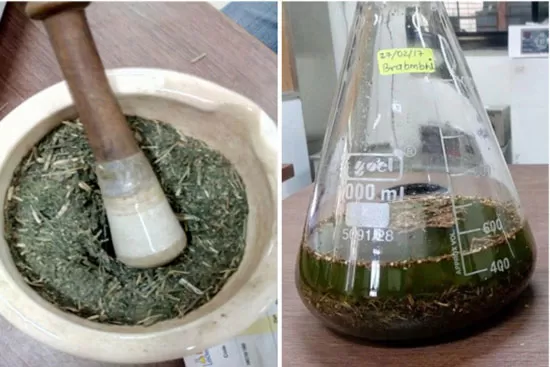- 0086-571-85302990
- sales@greenskybio.com
Overcoming Obstacles: Troubleshooting Guide for Common Issues in Plant Extract Column Chromatography
2024-08-10
1. Introduction
Column chromatography is a widely used technique in the analysis and purification of plant extracts. However, it is not without its challenges. This troubleshooting guide aims to provide comprehensive solutions to common problems encountered during plant extract column chromatography. By understanding and addressing these issues, researchers can ensure more accurate results and efficient chromatography runs.
2. Issues Related to the Stationary Phase
2.1. Column Packing Problems
Problem: Uneven column packing can lead to poor separation efficiency.
Solution:
- Ensure that the stationary phase is evenly distributed during packing. Use a proper packing device or gently tap the column to settle the packing material uniformly.
- Check for air bubbles in the column. Air bubbles can disrupt the flow path and affect separation. If present, carefully remove them by gentle agitation or vacuum degassing.
2.2. Stationary Phase Degradation
Problem: Over time, the stationary phase may degrade, leading to changes in its properties and reduced separation performance.
Solution:
- Store the stationary phase properly according to the manufacturer's instructions. This may include storing in a cool, dry place away from light and reactive chemicals.
- Regularly check the performance of the stationary phase. If a decline in separation efficiency is noticed, consider replacing the stationary phase.
3. Sample Preparation - Associated Issues
3.1. Insufficient Sample Solubility
Problem: If the plant extract sample is not fully soluble in the mobile phase, it can cause clogging in the column or uneven distribution.
Solution:
- Optimize the solvent system for sample dissolution. Try different solvents or solvent mixtures that are known to have better solubility for the components in the plant extract.
- Use sonication or gentle heating (if the sample is stable) to enhance solubility. However, be careful not to degrade the sample during these processes.
3.2. Sample Contamination
Problem: Contaminants in the sample can interfere with the chromatography process, leading to false peaks or reduced separation.
Solution:
- Implement proper sample purification steps before chromatography. This may include filtration, centrifugation, or extraction techniques to remove particulate matter, proteins, or other interfering substances.
- Ensure that all glassware and equipment used in sample preparation are clean and free from residue. Wash thoroughly with appropriate solvents and dry before use.
4. Mobile Phase - Related Problems
4.1. Incorrect Mobile Phase Composition
Problem: An improper mobile phase composition can result in poor separation or retention of components.
Solution:
- Review and optimize the mobile phase composition based on the chemical nature of the plant extract components. Consider factors such as polarity, acidity, and basicity.
- Refer to existing literature or perform preliminary experiments to determine the most suitable mobile phase composition. Gradient elution may also be considered to improve separation in complex samples.
4.2. Mobile Phase Degradation
Problem: The mobile phase may degrade over time, especially if it contains unstable components. This can lead to changes in its chromatographic properties.
Solution:
- Prepare the mobile phase fresh when possible. If storage is necessary, store it under appropriate conditions, such as in a sealed container in a refrigerator for some volatile or reactive components.
- Regularly check the performance of the mobile phase. If any signs of degradation (such as changes in pH or appearance) are observed, prepare a new batch.
5. Flow Rate and Pressure Issues
5.1. High - Pressure Problems
Problem: Excessive pressure in the column can damage the system and lead to inconsistent results.
Solution:
- Check for clogged frits or tubing. If clogged, clean or replace them. Clogs can occur due to sample residues, particulate matter in the mobile phase, or stationary phase degradation products.
- Ensure that the flow rate is within the recommended range for the column. A too - high flow rate can cause high pressure. Adjust the flow rate gradually if necessary.
- Examine the column for any signs of blockage or damage. If the column is blocked, it may need to be repacked or replaced.
5.2. Low - Flow Rate or No - Flow Situations
Problem: A low - flow rate or no - flow can result in long analysis times or incomplete separation.
Solution:
- Check for leaks in the system. Leaks can occur at fittings, valves, or tubing connections. Tighten connections or replace damaged parts if necessary.
- Inspect the pump for proper operation. A malfunctioning pump can cause low - flow or no - flow problems. Check for air in the pump head and remove it if present.
- Verify that the column is not blocked. If the column is blocked, follow the steps mentioned above for high - pressure problems to resolve the blockage.
6. Detection and Quantification Issues
6.1. Poor Peak Shape
Problem: Peaks may be broad, tailing, or fronting, which can affect quantification accuracy.
Solution:
- Check the column efficiency. A degraded column or improper column packing can lead to poor peak shape. Consider repacking or replacing the column if necessary.
- Optimize the mobile phase composition and flow rate. These parameters can have a significant impact on peak shape. Adjust them based on the nature of the analytes.
- Ensure that the sample is properly prepared and free from contaminants that could cause peak distortion.
6.2. Inaccurate Quantification
Problem: Incorrect quantification can occur due to various factors such as detector calibration, sample matrix effects, or improper peak integration.
Solution:
- Regularly calibrate the detector using appropriate standards. Ensure that the calibration curve is linear over the concentration range of interest.
- Account for sample matrix effects. This may involve using internal standards or matrix - matched calibration standards to correct for any interference caused by the sample matrix.
- Review and optimize the peak integration method. Use appropriate software tools to ensure accurate peak area or height measurement.
7. Conclusion
Plant extract column chromatography can be a complex process, but by being aware of and addressing common issues related to the stationary phase, sample preparation, mobile phase, flow rate and pressure, and detection and quantification, researchers can overcome obstacles and achieve reliable and accurate results. Regular maintenance, proper sample handling, and optimization of chromatographic parameters are key to successful plant extract column chromatography.
FAQ:
Q1: What should be done if the stationary phase in plant extract column chromatography shows poor separation efficiency?
There could be several reasons for poor separation efficiency of the stationary phase. First, check if the stationary phase is properly packed. Uneven packing can lead to irregular flow paths and poor separation. Repack the column carefully following the recommended procedures. Second, the type of stationary phase might not be suitable for the specific plant extract. Consider changing to a more appropriate stationary phase based on the chemical nature of the compounds in the extract, such as using a reversed - phase C18 for more polar compounds if the current phase is not effective. Also, make sure the stationary phase is clean and free from contaminants that could interfere with the separation.
Q2: How can sample preparation issues in plant extract column chromatography be resolved?
Sample preparation is crucial in column chromatography. If the sample is too concentrated, it may overload the column and cause poor separation. Dilute the sample to an appropriate concentration. Insoluble particles in the sample can clog the column. Filter the sample through a fine - pore filter (e.g., 0.45 μm or 0.22 μm) before injection. If the sample contains interfering substances, such as salts or other impurities, pre - treat the sample. For example, use solid - phase extraction to remove unwanted components or dialysis to remove salts. Additionally, ensure that the sample solvent is compatible with the mobile phase to avoid any phase separation or precipitation issues during chromatography.
Q3: What causes tailing peaks in plant extract column chromatography and how to fix it?
Tailing peaks can occur due to several factors. One common reason is the presence of active sites on the stationary phase that interact too strongly with certain components of the plant extract. To address this, end - capping the stationary phase can reduce these unwanted interactions. Another cause could be overloading of the column. If this is the case, reduce the sample amount. In some instances, the pH of the mobile phase may be incorrect. Adjust the pH to optimize the ionization state of the analytes and improve peak shape. Also, ensure that the mobile phase is properly degassed, as dissolved gases can sometimes cause peak distortion.
Q4: How to deal with slow flow rate problems in plant extract column chromatography?
A slow flow rate can be caused by a clogged column. Check for any blockages in the column, tubing, or frits. Clean or replace these components if necessary. The viscosity of the mobile phase can also affect the flow rate. If the mobile phase is too viscous, consider using a different solvent or adjusting the composition to reduce viscosity. A high - pressure drop across the column can slow down the flow. This could be due to a too - tightly packed column. In this situation, repack the column with a more appropriate packing density. Additionally, make sure that the pump used to deliver the mobile phase is working properly and is not clogged or malfunctioning.
Q5: What are the solutions when baseline drift occurs in plant extract column chromatography?
Baseline drift can be a nuisance in chromatography. Temperature changes can cause baseline drift. Ensure that the column and the detector are maintained at a constant temperature. If possible, use a column oven and a temperature - controlled detector environment. Another factor could be the mobile phase. Gradient elution can sometimes lead to baseline drift. Optimize the gradient profile, for example, by adjusting the rate of change of the mobile phase composition. Contaminants in the mobile phase or the system can also cause baseline drift. Use high - purity solvents and clean the system regularly, including the columns, tubing, and detector cells.
Related literature
- Advanced Techniques in Plant Extract Chromatography"
- "Optimization of Column Chromatography for Plant - Based Analyses"
- "Troubleshooting Column Chromatography: A Comprehensive Review with Emphasis on Plant Extracts"
- ▶ Hesperidin
- ▶ citrus bioflavonoids
- ▶ plant extract
- ▶ lycopene
- ▶ Diosmin
- ▶ Grape seed extract
- ▶ Sea buckthorn Juice Powder
- ▶ Beetroot powder
- ▶ Hops Extract
- ▶ Artichoke Extract
- ▶ Reishi mushroom extract
- ▶ Astaxanthin
- ▶ Green Tea Extract
- ▶ Curcumin Extract
- ▶ Horse Chestnut Extract
- ▶ Other Problems
- ▶ Boswellia Serrata Extract
- ▶ Resveratrol Extract
- ▶ Marigold Extract
- ▶ Grape Leaf Extract
- ▶ blog3
- ▶ blog4
- ▶ blog5
-
What are extracts made of?
2024-08-10
-
Extract Usage: A Comprehensive Guide
2024-08-10
-
Are plant extracts good for you?
2024-08-10
-
What are plant-based extracts?
2024-08-10
-
What Is a Plant Extract? A Deep Dive
2024-08-10
-
Red Wine Extract
2024-08-10
-
Polygonum Cuspidatum Extract
2024-08-10
-
Boswellia Serrata Extract
2024-08-10
-
Yellow Pine Extract
2024-08-10
-
Cactus Extract
2024-08-10
-
Echinacea Extract
2024-08-10
-
Avocado Extract Powder
2024-08-10
-
Black Garlic Extract
2024-08-10
-
Hesperidin
2024-08-10
-
Scutellaria Extract
2024-08-10































